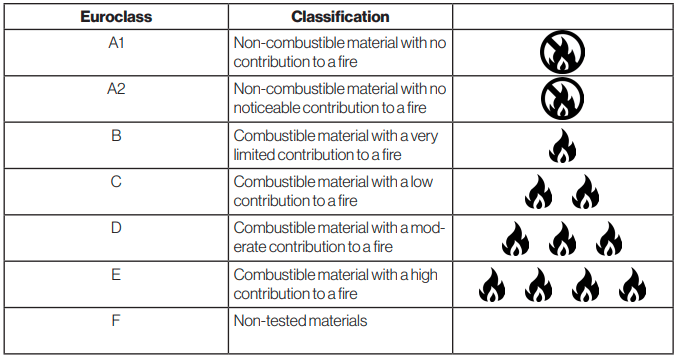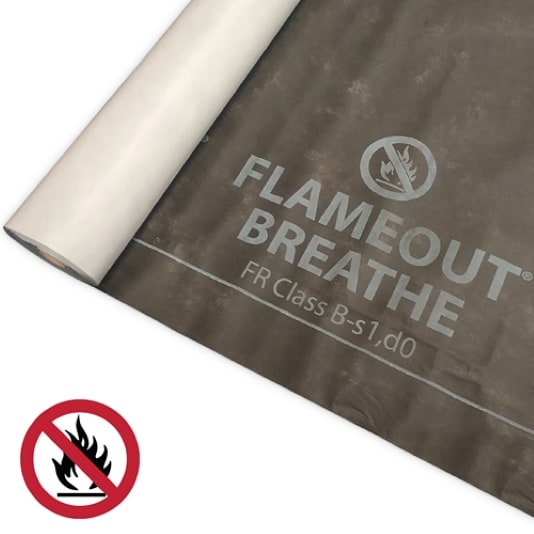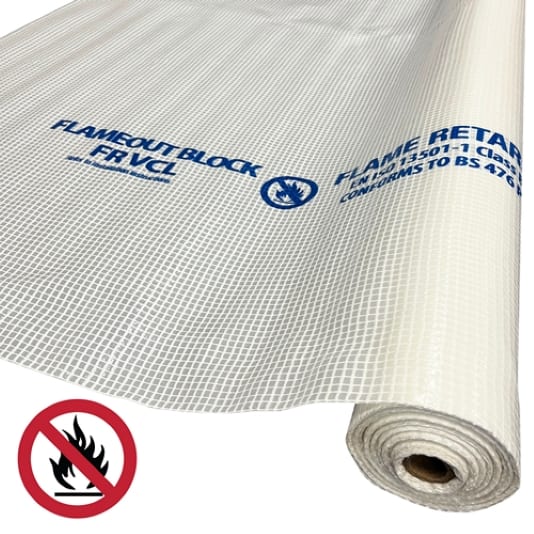
Fire retardant membranes explained
- Read time: 3 minutes
- Date: 31 Jan 2024
- Rainscreen & Façades
- Sheeting & Cladding
In this article we'll look at:
What fire retardant membranes are
The Euroclass classification system
How to fix fire retardant membranes
What are fire retardant membranes?
Since the Grenfell tragedy, there has been an emphasis on the compatibility and suitability of construction materials, especially on high-rise, high-risk residential and commercial buildings.
A fire retardant membrane is a waterproofing membrane designed as a barrier to control condensation and keep the external elements from damaging the construction of the building. In ventilated façade applications, this layer is crucial to form not just a water and weatherproof layer, but also act as a barrier to slow down flames (rather than assist the spread of), in the event of a fire.
An AVCL is an air vapour control layer, and will completely block the transfer of air and water vapour to ensure condensation doesn't become an issue within the façade build-up.
A breather membrane is another type of membrane used typically within façade applications - to repel water and control water vapour, to control condensation within the building's interior, and allow the building to 'breathe'.
What is Euroclass?
The Euroclass system is the European standard to gauge the performance of construction materials in the circumstances of a fire, testing whether the material contributes to or hinders the development of a fire in the early stages.
Stemming from the European Standard EN 13501, the European Reaction to Fire classification system (otherwise known as Euroclass) is widely considered as the most respected and accurate standard to follow, advised and used by many organisations to classify their construction products as they react to fire.
There are 7 classifications ranging from completely non-combustible, to fully combustible.

What's the difference between A1 and A2 if they're both non-combustible?
A1 classified materials are completely non-combustible and will not contribute to a fire at all. However, A2 classified materials may burn and contribute to a fire - but negligibly so and will not instigate or speed up the development of a fire. The only difference in materials between A1 and A2 is that A2 classified materials may include components that could burn in a fire.
As well as the 7 classifications, there are additional (sub)classes to classify specifically in relation to smoke development and flaming droplets.

Not all of these sub-classes relate to the testing of materials - however, as mentioned later on, some industries specify that materials must be A1-s1, d0 classification: non-combustible, producing very little smoke, and with no flaming droplets at all.
How are materials tested?
Within the Euroclass rating system, there are a few different properties that are assessed, including:
Non-combustibility
Does the material significantly (or not) contribute to a fire?
Ignitability
Does the material ignite?
Flame spread
How fast and how far does the material assist the spread of the flame?
Calorific value
What is the total heat release of the material when burned completely?
In regards to construction membranes, they are subject to 2 specific types of testing:
EN 1195-2 Single Flame Source Test
A test specimen is vertically oriented and then a flame is applied to the surface, and tested to assess ignitability and flame spread, as well as the production of smoke development and flaming droplets.
EN 13823 (SBI) Single Burning Item Test
In the SBI Test, a test specimen is mounted in a mock application, and the reaction to fire is assessed instrumentally and visually.
In both types of testing, there are benchmarks that are set for these materials in order to classify as the relevant classifications.
How does Euroclass apply to membranes?
Current regulations for external walls state that the systems must meet a minimum Euroclass A2-s1, d0 fire safety rating - which means limited combustibility. However, in façade applications, membranes are exempt from being part of an A1 or A2-s1, d0 vertical façade/wall application - and by law, the membranes are required to have a minimum Euroclass rating of B-s3, d0.
In the future this is likely to change, and A rated membranes are set to become the future of breathable membranes within façade and rainscreen applications.
What's the difference between membrane classifications?
We offer 3 fire retardant membranes as part of our range:
SAFE ONE breather membrane
Class A2-s1, d0 classified: No noticeable contribution to a fire, very little smoke production and no flaming droplets produced
FLAMEOUT-BREATHE-FR breather membrane
Class B-s1, d0 classified: Little contribution to a fire, very little smoke production and no flaming droplets produced
FLAMEOUT-BLOCK-FR air vapour control layer
Class B-s1, d0 classified: Little contribution to a fire, very little smoke production and no flaming droplets produced
How do you fix the different membranes?
The fire rated membranes we offer are supplied as rolls of material 50 metres long, which are cut to the correct size needed on-site. Where the membranes overlap, join tape (FLAMEOUT-TAPE) is used to seal the membranes.
Here's the 3 membranes we offer:

Class A2-s1, d0, and can be used within enclosed walls or on partially open façades with gaps between the cladding (up to a maximum of 50mm). Compliant with UK Building Regulations Approved Document B. N55 and SAFE ONE Glue cartridges must only be used as part of the installation of this membrane.

As well as being flame retardant, this breather membrane offers water-repellent properties to control condensation within the building's interior. FlameOut tape may also be used within the installation of this membrane.

Installed on the warm side of insulation, this VCL protects the building from interstitial condensation.
Please refer to the installation guidance for best practice on how to install the membranes correctly.
In summary, Euroclass classified flame retardant membranes are the future of façade and rainscreen vertical wall applications - compliant, safer buildings start with approved and tested components.

